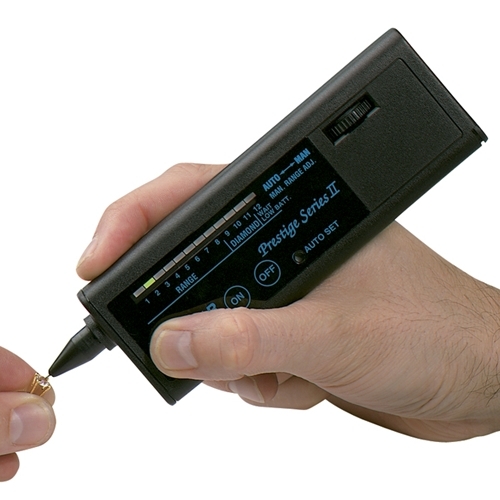History of Diamond Testers
The most common way a jewelry store differentiates between diamonds and diamond alternatives is by the use of a handheld diamond tester. Diamonds are excellent conductors of heat, while cubic zirconia, for example, are not. Therefore the original handheld diamond tester was a simple heat probe.
New Testers Developed In Response to Moissanite
When Moissanite came on the scene in the 2000's, it rendered the thermal diamond probes useless because it is an excellent conductor of heat. Therefore it would falsely test positive as diamond. In response, new testers were developed that also tested how well the gem conducted electricity. Whereas Moissanite conducts heat and electricity well, most diamonds are not good electrical conductors. So based on how well the gem conducts heat and electricity, the tester makes a guess as to the identity of the gem.
Flaw In The Way Diamond/Moissanite Testers Work
The problem with differentiating between Moissanites and diamonds based solely on whether or not it conducts electricity is that there exists a type of diamond that is electrically conductive. Its technically known as a "type 2" diamond. Due to the existence of trace amounts of boron in the diamond crystal, type b diamonds conduct heat and electricity, and so they can falsely be identified as Moissanites by handheld testers. Does that mean they are really Moissanite? No! It means the diamond tester is wrong.
The lab diamonds sold by MoissaniteCo.com are type 2 and made via HPHT technology which makes colorless diamonds possible. In our opinion they are the best quality lab grown melee diamonds on the market. As type 2 diamonds, they are electrically conductive and can falsely be identified as Moissanite. However a trained gemologist should be able to differentiate between lab diamonds and Moissanite via examination of the gems. For example, Moissanites are doubly refractive whereas diamonds, natural and lab, are not, and a jeweler should easily be able to observe this under magnification. (Sadly too many jewelers use the diamond/Moissanite tester as a crutch and rely on it exclusively).
In our own testing we have found that not all lab diamonds were falsely identifed as Moissanite on handheld diamond testers: some falsely identified as Moissanite, some as diamond and some were even identified as "metal" (which is an option on the tester). We believe this is due to varying electrical conductivity from stone to stone (with metals being the most electrically conductive of them all). Our hypothesis is backed up by the GIA article linked to at the end of this article. Unfortunately given how new these stones are to the market, little research has been done in this regard.
We currently have a 3rd party gemological laboratory and a materials analysis laboratory performing testing on our lab diamonds, and we will be making the results of the testing available as soon as they have completed their research (eta May 2018).
For additional reading
Brilliant Earth also states that lab diamonds can falsely test positive as Moissanite
GIA article on Indentifying Lab Grown Diamonds
Discussion among diamond dealers concerning Moissanite testers misleading on type 2b diamonds

